![]()
![]()
![]()
Use LEFT and RIGHT arrow keys to navigate between flashcards;
Use UP and DOWN arrow keys to flip the card;
H to show hint;
A reads text to speech;
61 Cards in this Set
- Front
- Back
|
how much fluid drains into the interstitial fluid faily? how uch is drained to lymphatics and how much to bllood?
|
30L
90% bleed, 10% lymph |
|
|
what can happen to healing when lymph is blocked? why?
|
it can slow or cause adhesions or fibrosis because the immune mediators and cells are lingering there and prolonging inflammation
|
|
|
where is the lymph system absent
|
CNS, bone marrow, cartilage, lens, placenta, epidermis, and inner large blood vessels
|
|
|
7 steps of where the lymph goes and drains
|
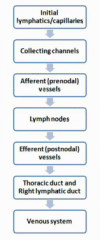
|
|
|
where exactly does lymph drain in the veins?
|
in the corner between the internal jugular and the subclavian
|
|
|
how are the initial lymphatics arranged cellularly?
two things present in arterioles that the lymphatics don't hae? |
overlapping one cell layers to prevent backflow
no tight junctions or SM |
|
|
what are anchoring filaments and what are they good for?
|
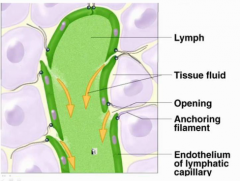
anchor the initial lymphatics to the tissue to prevent collapse when lymph is empty
|
|
|
what are some features of the collecting lymph vesse;ls? 2 describe each
|
valves- bicuspid
smooth muscle- progressively thicker |
|
|
what are the prenodal and post nodal vessels?
|
the collecting vessels before and after the lymph nodes
|
|
|
what happens to aid drainage in the lymph npodes? name the exact site?
|
hydrostatic water movement from sinusoids of lymph nodes to the veins
|
|
|
What is the 2 main functions of the lymph nodes?
|
filtratioon and generation of antigens to foreign substances
|
|
|
wwhere do the efferent lymphatic vessels like to head towards?
|
the follow the fascial planes toward the midline up to the cervico-thoracic junction (where the jugular meets the subclavian)
|
|
|
why are the lymphatics so vulnerable to backing up?
|
since they run in the fascia and those are also vulnerable to tightness
|
|
|
what are the two main dranage ducts called?
|
right lymphatic
left thoracic |
|
|
what parts of the body does the right lymphatic duct drain?
|
right half of head and neck, arm, lung, breast, and thorax (all RUQ of head/thorax)
also the heart |
|
|
what happens to the interstitium with failure of the lymphatics?
|
it swells with water, metabolic waste, and proteins that get backed up there
|
|
|
what is the formation phase?
|
when extracellular fluid moves into the lymph capillaries
|
|
|
what kind of gradient exists between the lymph capillaies and the interstitium? Why?
|
it is uphill going from the interstitium to the lymph because you are usually draining upwards
|
|
|
what kinds of things will help lymph flow against this upward stack of fluid? 3
|
skeeletal muscle contraction, tissue compression (pump/compression stockings), and arterial pulse
|
|
|
What is the vascular phase?
|
when the lymph moves through the vessels
|
|
|
what is the role of the SM in the vessels?
|
they have intrinsic perotalsis to help move the fluid forward
|
|
|
what regular movememtns of ours helps with the vascular phase?4
|
skeletal muscle movement, arterial pulse, visceral motions like peritalsis, respiration
|
|
|
what innervates the lymphatics? what other technique does this match up with?
|
sympathetics- chapman;s
|
|
|
what kind of stuff should you say when performing a technique in the practical?
|
some indications and counterindications and explain it in general (they will not prompt you)
|
|
|
where is sibson's fascia?
|
the thoracic inlet area
|
|
|
where do you want to start opening up lymph channels from?
|
from central (thracic inlet then diaphragm) to outward and peripheral
|
|
|
What is the terminal stage?
|
when the lymph coleccts into the regional collecting sites
|
|
|
should you push on a swollen lmph node? why>
|
no because it is swollen for a reason- there is no where to for it to drain
|
|
|
how do ou do disphragmatic doming?
|
put thumbs into the diaphragm from the costal margin.
dig thumb up with exhale resisst diaphragm with inhale |
|
|
how do you dx with popliteal fossa?
tx? |
put fingers on medial and lateral of the popliteal fossa
motion test up down, and sisde to side to find restriction treat toward restricition |
|
|
how do you do thoracic pump? how many pumps?
|
put hands on upper chest with thumb around neck. push down on exhalation and resist with inhalation
3-5 times |
|
|
how do you do pedal pump? for how long?
|
push on their toes flexed for a couple minutes (but like 030 seccs for lab)
|
|
|
How do you do effleurage?
|
raise the leg up
work from proximal to distal with both hands pushing deep and in a wringing motion like you are pushing lymph up. |
|
|
where is sibson' fascia?
|
above the calvicle on either side there the thoracic/lymphatic ducxt goes in
|
|
|
where is the superior thoracic inlet?
|
around the sternum
|
|
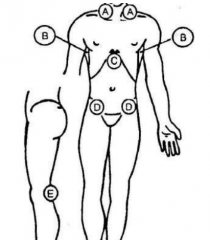
|
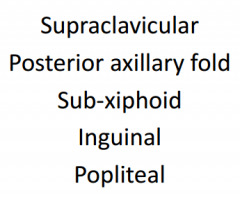
|
|
|
What does the Zinc model say? what is it?
|
the respiratory-circulatory model
35-60% of thoracic duct flow is produced by respiration |
|
|
what happens to the throacic diaphragm when it gets tight?
breathing and lymph consequence? |
it will flatten- harder to create pressure gradients to breath and will kink off lymph vessels going to the thorax
|
|

what two muscles go through the diaphragm here?
|
psoas and uadratus lumborum
|
|
|
main mechanism by which respiration help lymph flow?
|
pressure differences
|
|
|
what is the goal of lymphatic treatment?
|
remove the key tissue stresses interfereing with flow of body fluids
|
|
|
what is reciprical inhibition?
|
when you contract the anatagonist to relax a muscle reciprically just by reflex
|
|
|
what is the order of regions you should treat if the obstruction is in the feet?
|
thoracic inlet
diaphragm pelvic floor popliteal fossa |
|
|
6 ways you can open up channels?
|
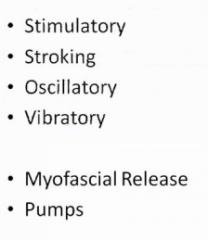
|
|
|
what are the two main things you are doing in order to release lymph?
|
1. open up channels
2. move the lymph |
|
|
What 4 techniques will help to open up the channels?
|
1. thoracic inlet/outlet steering wheel
2. pectoral traction 3. doming of diaphragm 4. popliteal fossa release |
|
|
What 4 techniques will help to pump the lymph?
|
1. miller thoracic pumps
2. pedal pump 3. rib raising 4. effleurage/petrissage |
|
|
what fascia is involved in the sterring wheel release?
|
sibson's fascia
|
|
|
how many times does the thoracic duct pass through the sibson's fascia before dumping into the veins?
|
twice
|
|
|
where does the respiratory diaphragm attach to bones?
|
L1-3
transverse process of T12-L1 12th rib |
|
|
what muscles is the diaphragm associated with?
|
quadratus lumbortum, psoa, and transversus abdominus
|
|
|
follow the path of fluid from inhalation and exhalation from the abdomen to the brachiocephalic vein.
|
inhale- pulls fluid into chest from abdomen
exhalae- fluid pulled into the neck inhale- fluid pulled into brachiocephaic vein |
|
|
what is the freq of a lyphatic pump?
|
2/sec
|
|
|
what is another name for the thoracic pump?
|
the miller thoracic pump
|
|
|
2 types of miller thoracic pumps?
|
the normal one and the exaggerated respiration one
|
|
|
how do ou do the exaggerated respiration version?
|
have hands on pt
have them take 3 quick breaths while resisiting them but on the last breath, you let go so the chest expands really quickly |
|
|
what is 1 counter indication to the miller thoracic pump and why?
|
COPD because you can pop blebs this way.
|
|
|
difference between effleurage and petrissage?
|
petrissage is deeper
|
|
|
what is the point of rib raising?
|
to stimulate the sympathetic innervation to the lymphatics
|
|
|
WHat are a couple indications for lymphatic technique?
|
sprains, strains, CHF, inflammation, pregnancy, infection, lymphatic/venous stasis, edema
|
|
|
What are 2 absolute counterindications to lymphatic technique?
|
anuria and necrotiing fascitis
|

